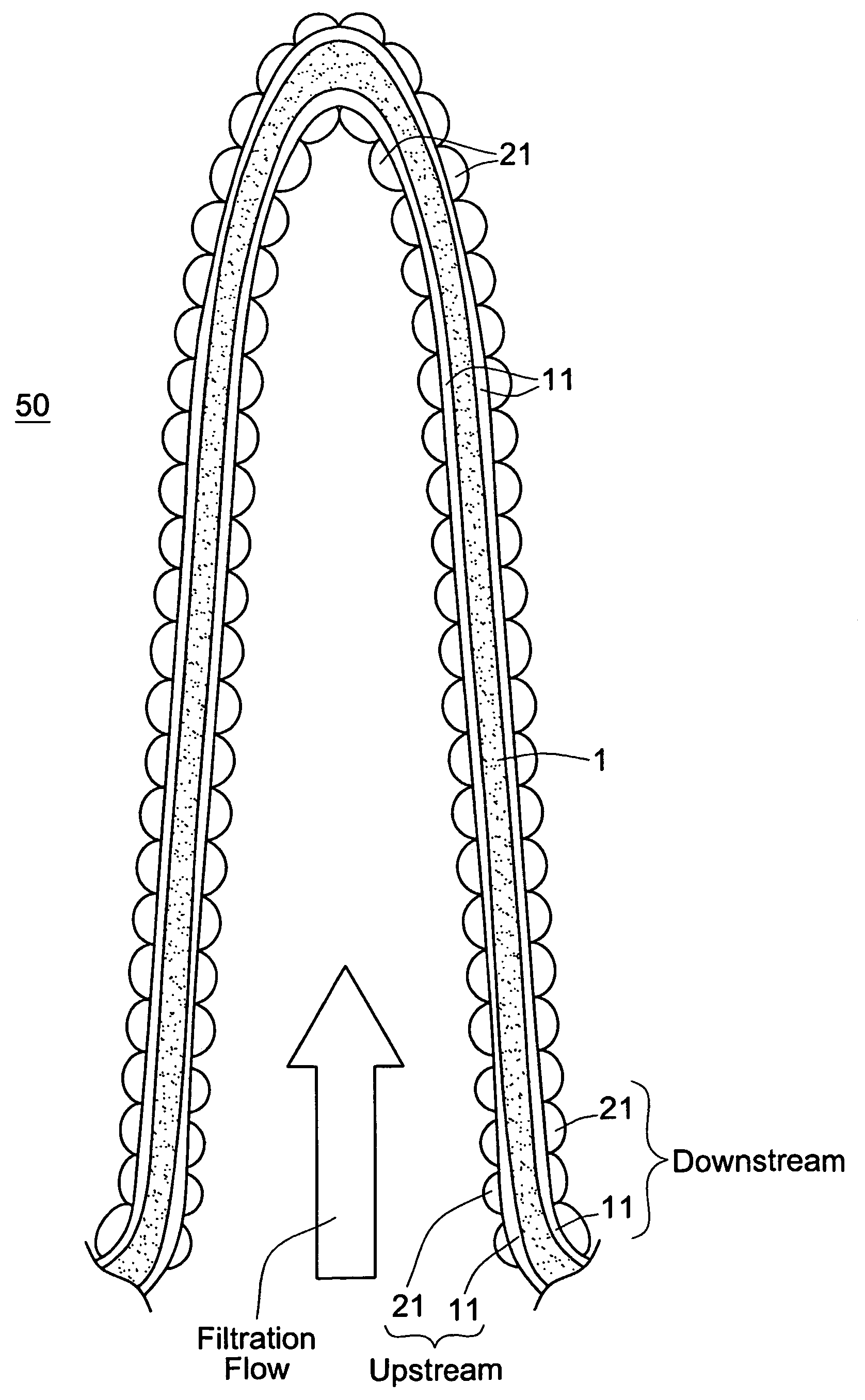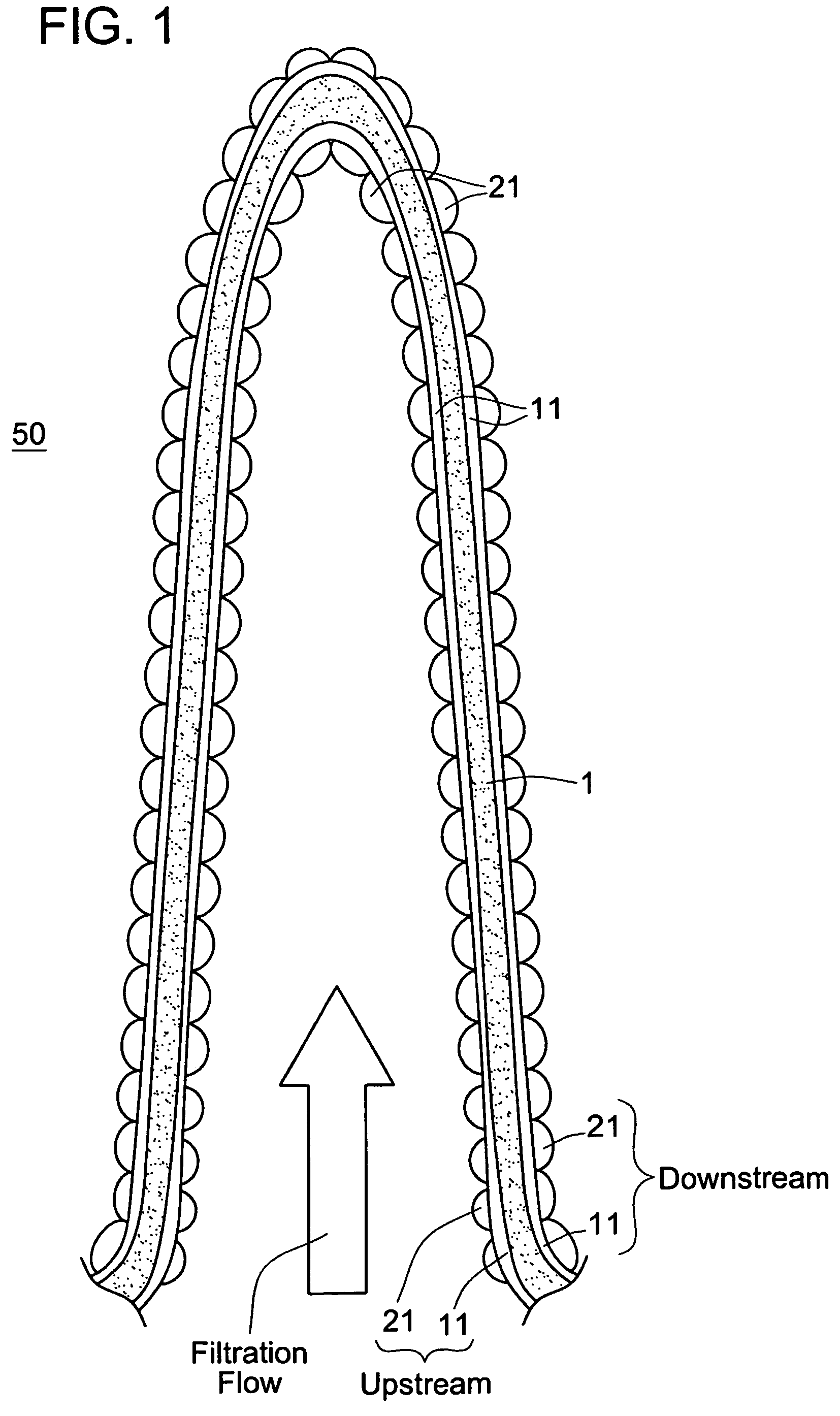Blended polymer media for treating aqueous fluids
a technology of polymer media and aqueous fluid, which is applied in the field of media and methods for treating fluids, can solve the problems of filter media suffering from a variety of drawbacks, damage to the filter medium or the housing containing the filter medium, and media fouling
- Summary
- Abstract
- Description
- Claims
- Application Information
AI Technical Summary
Benefits of technology
Problems solved by technology
Method used
Image
Examples
example 1
[0082] This example demonstrates the preparation of a porous blended polymer membrane having a first, essentially hydrophobic polymer and a second polymer that is a random copolymer entangled with the first polymer, the second polymer being more hydrophilic than the first polymer, the second polymer being present in a ratio to the first polymer that is substantially uniform at the surfaces and through the bulk of the membrane.
[0083] A 23000 g batch of polymer solution containing 17% solids by weight is prepared by dissolving the solids in a 75 / 25% DMAC / EAA (dimethyl acetamide / ethyl acetoacetate) solution with the solids consisting of 80 wt % PVDF (Kynar 761 / 761A, 50 / 50 mix) and 20% comb polymer (a random copolymer with a poly (methyl acrylate) (Ma) backbone and polyoxyethylene methacrylate (POEM) and hydroxy-terminated polyoxyethylene methacrylate (HPOEM) side chains P(Ma-r-POEM-r-HPOEM)) (Doresco AC403-5; Dock Resins Corp., Linden, N.J.). The dissolution temperature is 44.6° C.
[0...
example 2
[0088] This example demonstrates that embodiments of membranes prepared according to the invention can be repeatedly cleaned while maintaining desired performance characteristics.
[0089] Two membranes are prepared as generally described in Example 1, except the dissolution temperature is 39.7° C. The membranes have a removal rating of 0.05 micrometers, and (when dried) a KL of 55 psi.
[0090] Two filters are assembled, each having (from the upstream to downstream direction) a channeled mesh (0.030D; Delstar Technologies, Inc.; Middletown, Del.) (upstream support layer), a PVC nonwoven layer (1 oz / yd2) (an upstream drainage layer), the membrane, and a TYPAR® 3401 (Reemay, Inc.; Old Hickory, Tenn.) layer (a downstream cushioning layer).
[0091] A first filter is placed in a jig, and used to filter surface water for 70 hours. The filtration flow rate is 0.05 gallons per minute per square foot (gpm / ft2). Every hour, the filter is backwashed with water (corresponding to 4% of the filtrate)...
example 3
[0094] This example demonstrates that embodiments of membranes prepared according to the invention can be repeatedly backwashed with water so that a high percentage of the increase in differential pressure is removed. In this experiment, about 60 to about 80% of the build up in differential pressure is removed upon backwashing with water.
[0095] A 750 lb batch of polymer solution is made as follows. The non-solvents ethylene glycol (4 parts), ethylene glycol monomethyl ether (5 parts), acetone (32) parts, and methyl acetate (9 parts) are added in a reactor and mixed. PVDF (Kynar-761 resin) (15 parts) is added to the reactor containing the nonsolvents. A vessel is filled with DMAC (29.3 parts) and stirred. Comb polymer (Doresco AC403-5; Dock Resins Corp.) (5.7 parts) is then added to the DMAC vessel and stirring continues until blending is complete. The polymer / solvent mixture is added to the reactor containing the non-solvents / resin. The reactor is slowly heated to 130° F. (about 53...
PUM
| Property | Measurement | Unit |
|---|---|---|
| Length | aaaaa | aaaaa |
| Flow rate | aaaaa | aaaaa |
| Concentration | aaaaa | aaaaa |
Abstract
Description
Claims
Application Information
 Login to View More
Login to View More - R&D
- Intellectual Property
- Life Sciences
- Materials
- Tech Scout
- Unparalleled Data Quality
- Higher Quality Content
- 60% Fewer Hallucinations
Browse by: Latest US Patents, China's latest patents, Technical Efficacy Thesaurus, Application Domain, Technology Topic, Popular Technical Reports.
© 2025 PatSnap. All rights reserved.Legal|Privacy policy|Modern Slavery Act Transparency Statement|Sitemap|About US| Contact US: help@patsnap.com


